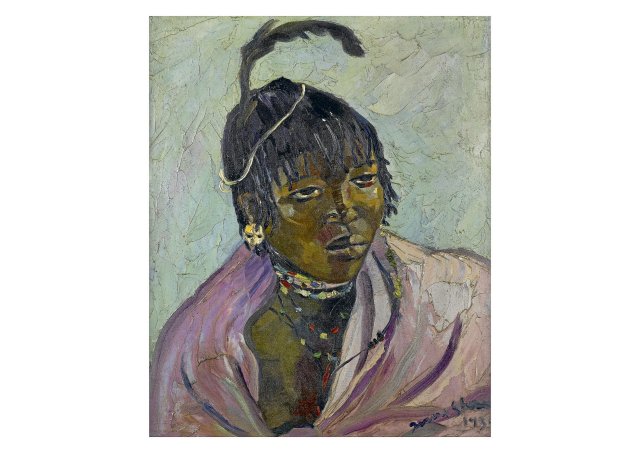Irma Stern, “Young Mpondo Woman”, 1935, oil on canvas, private collection
Photo: © Irma Stern Trust /VG Bild-Kunst, Bonn 2025; Photo: Courtesy of Strauss & Co
A black woman with a strikingly short and modern hairstyle, head, ear and necklace as well as a purple shoulder towel is captured with worthy serious and perhaps also skeptical view of an expression-looking picture. It is entitled “Young Mpondo Woman” and was painted by Irma Stern in 1935 in South Africa.
Irma Stern was born in 1894 as the daughter of the German Jews Samuel and Henni Stern in Swiss Reneke in Transvaal and died of heart failure in a hospital in Cape Town in 1966. The parents had gone to South Africa three years before their birth – the father successfully operated a general store there with his brother; So they were the winners of colonial policy. The Brücke Museum in Berlin dedicated to Expressionism now shows a breathtaking exhibition by Stern, which is largely unknown here, which “became the most important artist of modernity there in South Africa,” as curator Lisa Hörstmann explains in the accompanying catalog.
The Stern family lived again in Berlin from 1912 to 1920, where Irma Stern visited the private art and crafts school in Schöneberg initiated by the German Artists’ Association for a short time before moving to the Grand Ducal Saxon School in Weimar in 1913. Over the years, she met the Expressionist Max Pechstein, who appreciated her works and probably made sure that she was invited to the founding meeting of the November group, where she should be the only artist for the time being. With Pechstein, Stern demonstrably remained in letter contact until 1926.
Stern’s work was shown three times on the annual large Berlin art exhibition in Weimar Republic and was seen with many South African motifs in the renowned gallery Fritz Gurlitt in 1919. In addition, their paintings were also known in other countries in Europe through exhibitions. In the case of shorter stays in Berlin as well as from a distance, she followed the gradual rise of the NSDAP. As a Jewish and expressionist artist, after the handover of power to the Nazi party in 1933, she was twice marginalized and not only broke off all the connections to Germany, but also refused to speak German.
Even if white racists were outraged by black, the work in South Africa was worshiped as an original national art and Stern’s paintings were bought by state museums in order to also show them abroad as representative art from South Africa. Especially the portraits of black people are sensibly examined not only by black art historians in traces of a racist perspective of Stern. However, they appreciate the appealing aesthetics and the dignified individuality in the portraits of Stern at a time when white painters only perceived the majority of the population as service staff, but by no means as motives for their art.
Stern, who was pursued as a Jewish artist in Germany and whose work was classified as “degenerate”, with a few exceptions, however, refrained from naming the names of the portrayed. In doing so, she reduced this image or in “Watussi Girl” from 1946 as well as in “Maid in Uniform” from 1955 solely to her ethnic origin or to the serving function in the country dominated by white. If Stern had done this with the white portrayed, one could compare their method with that of the photographer August Sander, who tried a typology by profession and function in the German Society of the 20th century.
However, she denied the black people a piece of her personality and thus also manifested apartheid, whose segregation policy she was opposed, even if she knew exactly that this would take revenge one day. In 1955 she confessed in a letter that expresses her ambivalent attitude: »The beautiful, fairytale view of the life of the blacks – which my early work – can hardly continue (…). Of course, I can understand their sudden awakening and the determination that your country is full of white – the foot on your neck – but I still cannot say that I look happy and peacefully into the future ›of our ‘South Africa. We just wait passionately for a large bloodbath. We fuel it every day – every hour – give our left hand and take the right. «
However, it should be warned of hastily outrage and well -being sentenced from a historical distance, because it is important to consider that colonialism and racism were prevailing and affirmed ideologies until the middle of the 20th century. The fact that star was mostly respectful of the black population in their paintings and also kept contact with them and even partially supported anti-apartheid activists, the audience should keep their works in addition to the high aesthetic quality of their works.
»Irma Stern. An artist of the modernity between Berlin and Cape Town «, Brücke-Museum Berlin, until November 2.
